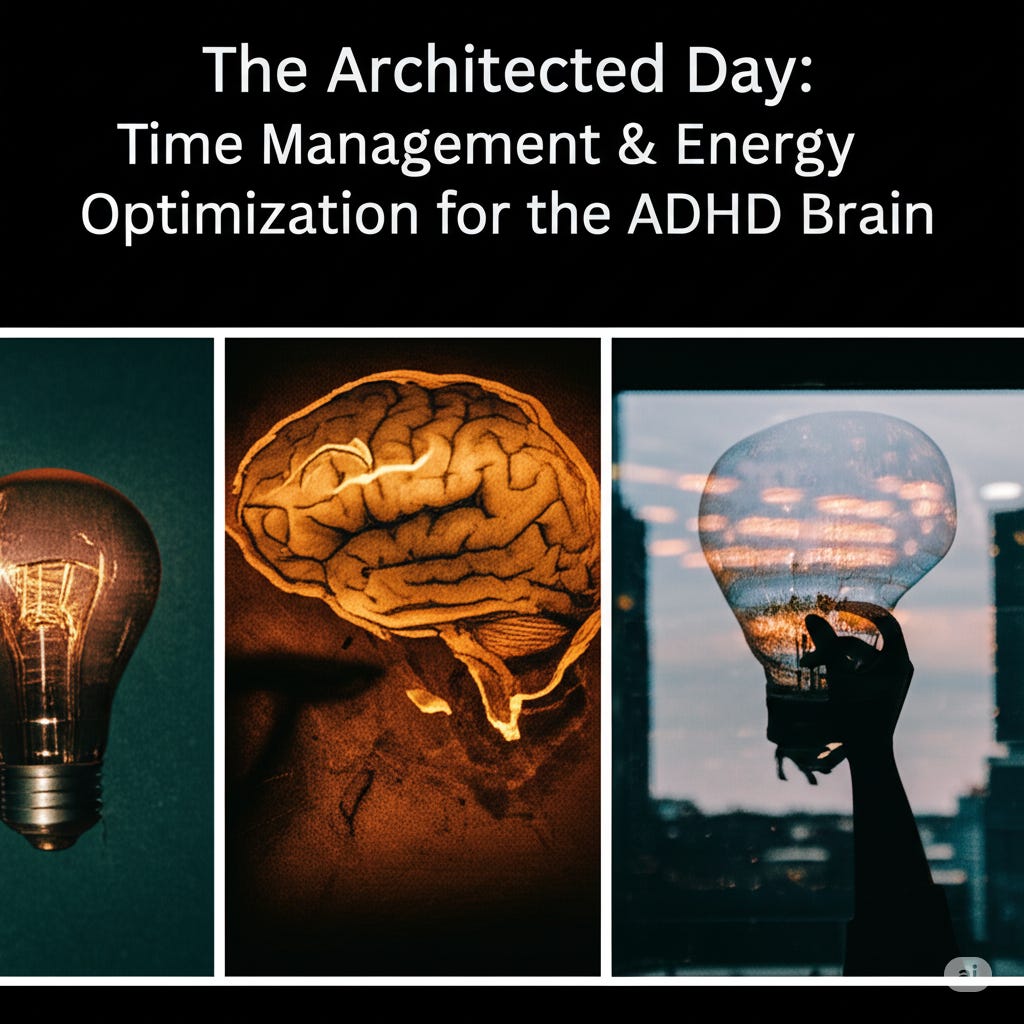The Architected Day: Time Management & Energy Optimization for the ADHD Brain
The Myth of the Linear Day
For minds navigating the world with ADHD neurology, conventional time management often feels like an ill-fitting straitjacket. You've likely experienced this frustration: meticulously constructed calendars, color-coded to-do lists, unwavering commitment to linear, uninterrupted workdays. Yet despite diligent effort, the day inevitably derails.
This chronic mismatch isn't a testament to deficient commitment or discipline.
It's a direct consequence of neurobiological incompatibility.
Conventional time management, predicated on sustained linear focus and consistent energy output, fundamentally clashes with ADHD brain realities: distinct dopamine regulation, fluctuating attention patterns, and considerable "activation energy" required for task initiation and context switching.
This isn't willpower failure—it's neurobiological reality clashing with systems designed for different operational profiles.
This article presents a strategic alternative: The Architected Day.
Not another rigid template to impose, but a flexible, dynamic system engineered to work with your unique neuro-rhythms.
Mapping Your Neuro-Rhythm: The Personal Energy Audit
Beyond "Chronotypes": Precision in Self-Observation
Your objective: move beyond broad categories to pinpoint hourly or bi-hourly output patterns of your distinct cognitive system.
Key focus areas:
Deep work and complex analysis
Creative thinking and innovation
Routine tasks and administration
Rest and recovery
The 3-Day Energy Audit Protocol: Low-Friction Data Acquisition
Implement for three typical working days.
Tracking Directive (Hourly or Half-Hourly):
Energy Level (1–5 scale)
Focus Quality
Hyperfocus – Intense, sustained concentration
Scattered – Difficulty maintaining attention
Steady – Moderate focus
Drained – Depleted resources
Task Type
(Email, analysis, meetings, creative work, admin, breaks)Tools: Spreadsheet, journal, or notes app
Observation & Analysis: Revealing Your Internal Landscape
Identify:
Hyperfocus Convergence
Mental Scatter Zones
Energy Peaks & Plummets
Sustainable Focus Intervals
Pinpointing Peak Performance Zones (PPZs) & Low-Energy Zones
PPZs:
Optimal time for deep work, analysis, creativity, and problem-solvingLow-Energy Zones:
Ideal for admin tasks, breaks, or movement
By understanding inherent fluctuations, you move from fighting your neurobiology to strategically leveraging it.
Flexible Frameworks for Time Blocking: Designing for Adaptability
From Rigid to Fluid Blocks: Containing Energy, Not Suppressing It
Objective: Create boundaries that guide—rather than restrict—energy.
The "Burst & Reset" Method: Optimizing Intense Focus Cycles
Structure:
Focus Burst: 25–45 minutes
Mandatory Reset: 5–10 minutes
Pomodoro Technique is a baseline model for this framework.
Dopamine-Driven Task Pairing: Leveraging Intrinsic Motivation
Use rewarding activities as a cognitive ramp into less desirable tasks.
Examples:
Admin before creative session
Tedious emails before social reward (timed)
Flow-State Protection Blocks: Safeguarding Deep Work Zones
Implementation Protocol:
Declare PPZs sacred
Use tech barriers (DND mode, noise-canceling headphones)
Set communication boundaries
Protect your high-yield mental territory.
Pre-Scheduled Transition Time: Smooth Context-Switching
Insert 5–15 minute buffer periods between tasks or meetings.
Transition Activities:
Stretching
Walks
Hydration
Breathing resets
Strategic Task Placement & Context Efficiency: Advanced Optimization
Location-Based Task Batching: Minimizing Costly Context-Switching
Batch similar task types to preserve cognitive continuity.
Example Groups:
All meetings in one block
All creative tasks in one zone
All admin/logistics tasks together
Energy-Matched Task Allocation: Aligning Demand with Resource Availability
Use neuro-rhythm data to schedule:
High Energy (PPZs): Cognitive-heavy work
Low Energy: Admin, email, light planning
The "Micro-Project" Approach: Deconstructing Overwhelm
Break large tasks into micro-steps:
Instead of: "Write report"
Use:
Outline intro
Research stat
Write 1 paragraph
Format heading
Edit 1 section
Tiny wins build unstoppable momentum.
Interrupt-Buffering Strategies: Protecting Your Cognitive Perimeter
Tools:
Freedom, Cold Turkey, Airplane Mode
Noise-canceling headphones
“Do Not Disturb” signals
Protocols:
Communicate availability
Designate focus zones
Define emergency-only access paths
Unprotected focus is unsustainable focus.
Your Implementation Action Plan: Architect Your Strategic Advantage
Understanding the Transformation
Consciously architecting your day transforms internal chaos into cognitive sovereignty.
It liberates executive function, supporting:
Strategic thinking
Creative output
Deep work
Emotional regulation
The Living System Approach
The Architected Day is not static—it evolves.
Commit to:
Regular audits
Iterative changes
Adaptive frameworks
Data-driven decisions
Your Immediate Implementation Protocol
Step 1: Conduct 3-Day Personal Energy Audit NOW
Use methodology described above.
Step 2: Blueprint ONE Critical Block
Select one area:
Optimize morning routine
Protect deep work
Add transition buffers
Match task to energy dips
Step 3: Track and Iterate
Review weekly
Expand what works
Refine based on patterns
Your Strategic Commitment
Reflect:
What one key insight changed your view of time?
Which part of your day will you re-architect first?
Start small. Stay consistent. Claim sovereignty over your time.



